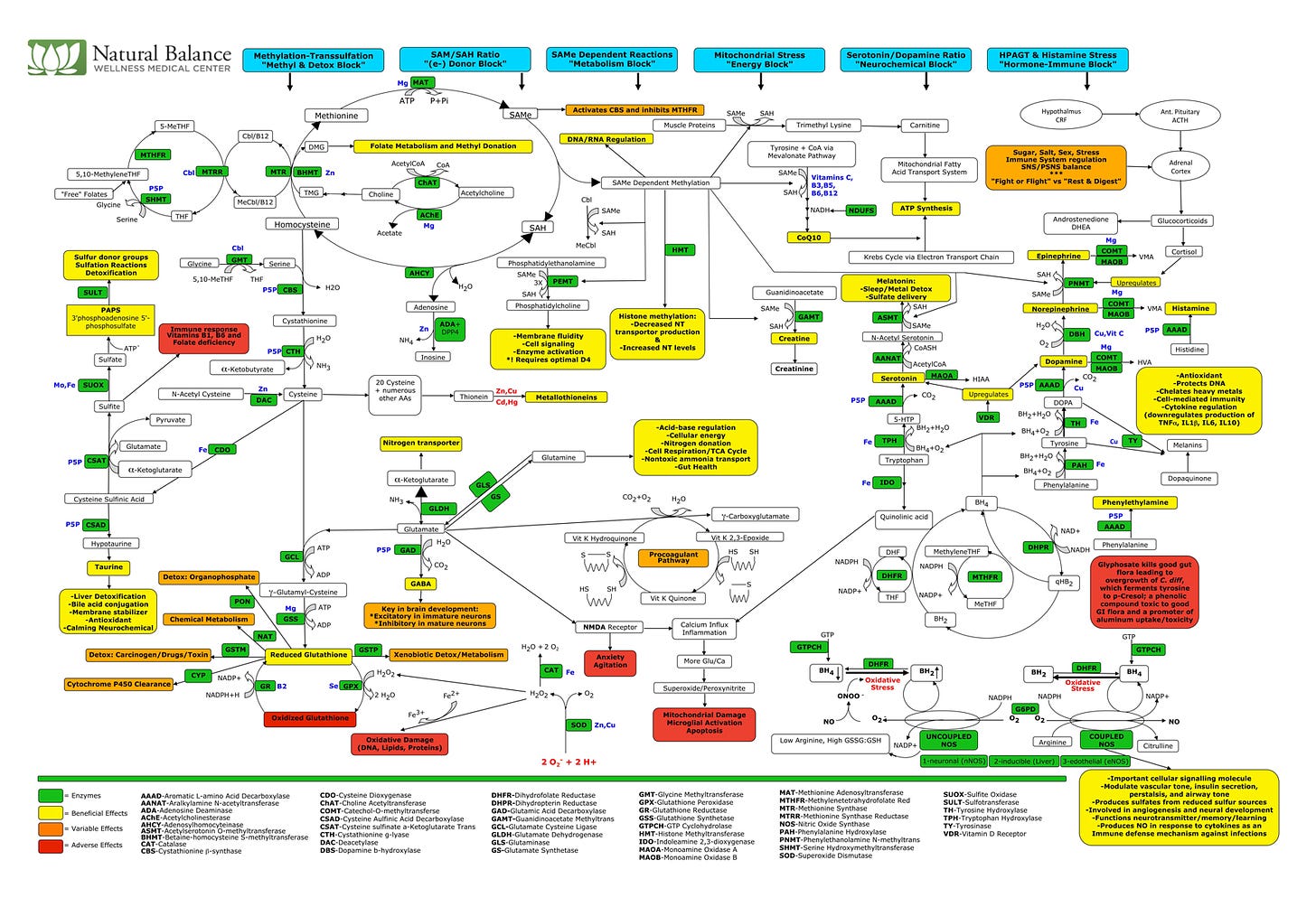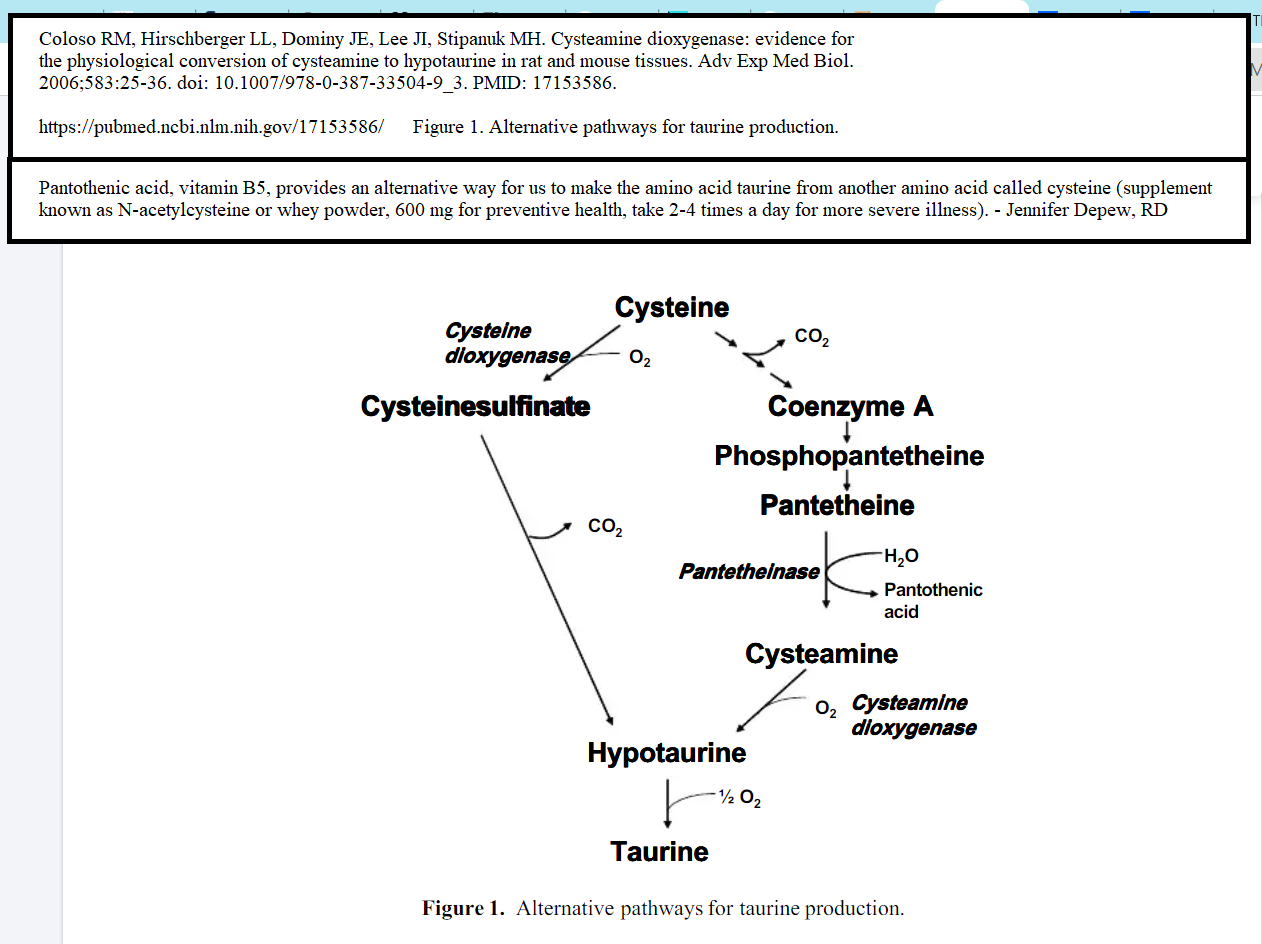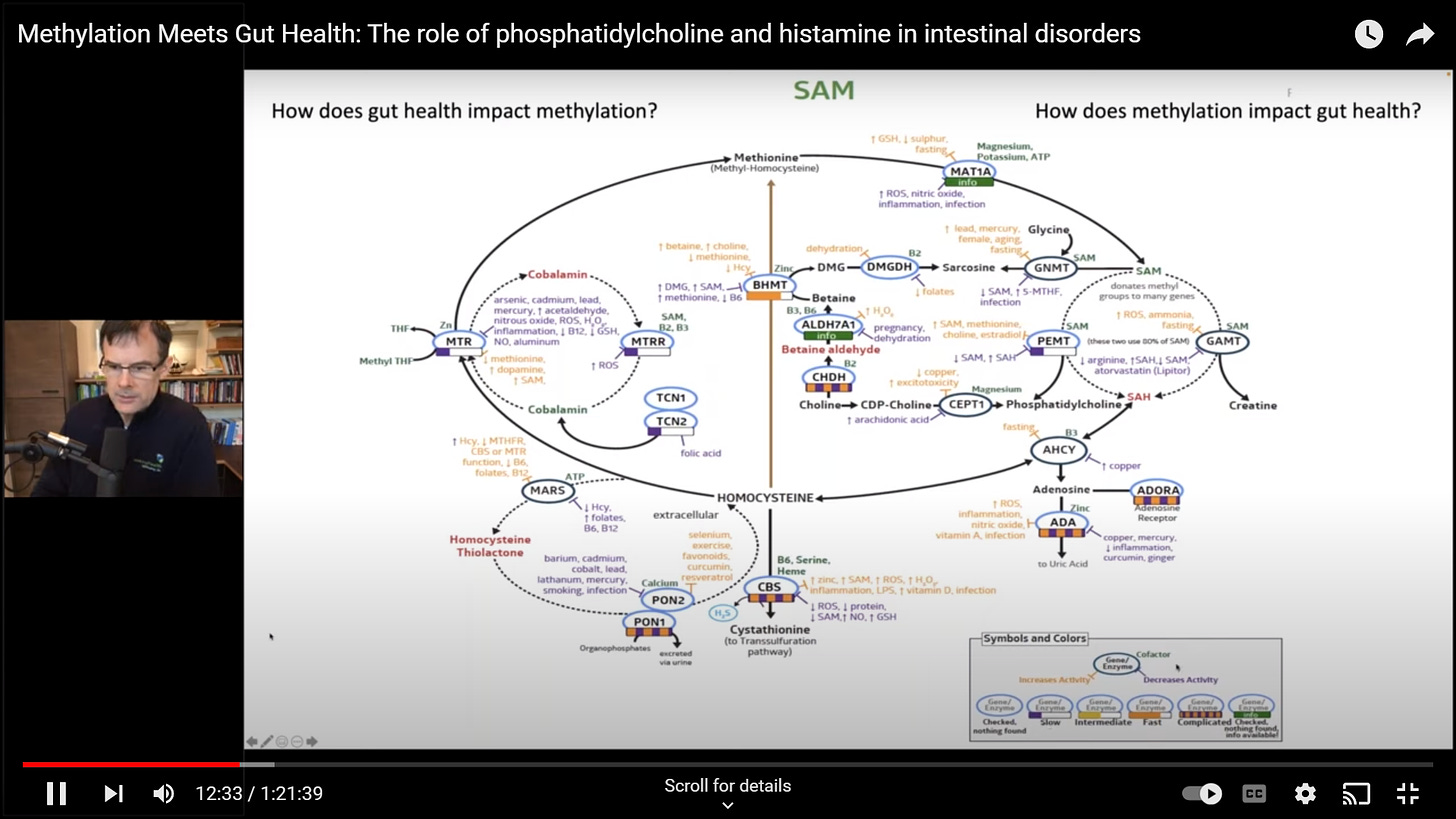Vitamin B5, taurine, and the transsulfuration cycle of the interconnected methylation cycles.
The B vitamins are your baseball team for moving ATP - balls of energy - around the methylation cycles as glucose is used to create more ATP; other chemicals are made & methyl groups are shared.
B vitamins are a team which work together within the interconnected methylation cycles. A deficiency in any one of the B vitamins can throw a wrench in the whole works, causing pile-ups in certain chemicals along the pathways. Which chemical piles up depends on the rate limiting missing nutrient or cofactor or trace mineral. Many things can cause a back-up somewhere in the complex plate of spaghetti graphic that represents our energy production cycles. Mitochondrial dysfunction could be another phrase to call methylation cycle dysfunction.
This post goes into detail regarding lifestyle or diet factors that can interfere with the interconnected methylation cycles, and has a summary list of some of main metabolic cycles that are involved: NAC - cysteine excess and negative feedback control of methylation cycles. And many other things that can disrupt the interconnected one-carbon methylation cycles. (Substack)
A simplified metabolic cycle might involve the conversion of chemical A into chemical B and back again to chemical A, which enzymes and the genes that encode the enzyme would be a step along the pathway and additional nutrients or cofactors might be listed too (depending on how simplified or detailed the graphic is intended to be). The conversion of methionine to homocysteine can lead to another methionine being created, or the homocysteine may be used to make cysteine for use in glutathione production or for other uses. Betaine provides a methyl group to be added back on the homocysteine to create methionine again. Dimethylglycine is produced from the molecule of trimethylglycine (betaine).

Unraveling the whole plate of spaghetti graphic gets more complex.

Pantothenic acid, vitamin B5, is generally easily obtained in the diet and rarely deficient, yet lack of it can cause significant illness in many areas of the body and brain - in humans or in ducks. Just 16 days of a pantothenic acid deficient diet, compared to a standard diet for the control group of Pekin ducks, caused significant changes in which genes were in use (changes from the control group showed up or down regulation of various genes.) The changes affected energy production but also extracellular proteins which would help protect the intestinal lining. The ducks couldn’t produce energy well or absorb more nutrients from the gut as well as in the control group. The ability to burn sugar for energy within the Citric Acid -Kreb’s -Tricarboxylic acid cycle was impaired and the ability to form more glucose from other chemicals (gluconeogenesis). The absorptive villi of the intestinal wall became shorter with reduced surface area for absorbing nutrients. (Tang, et al., 2021)
Nature loves a good design - we are like those ducks in more ways than having two eyes and a mouth (with teeth and lips instead of a beak).
“Compared to the [Control] CON group, high mortality, growth retardation, fasting hypoglycemia, reduced plasma insulin, and oxidative stress were observed in the [Pantothenic Acid Deficient] PAD group.
Furthermore, PAD induced morphological alterations of the small intestine indicated by reduced villus height and villus surface area of duodenum, jejunum, and ileum. The duodenum mucosal proteome of ducks showed that 198 proteins were up-regulated and 223 proteins were down-regulated (> 1.5-fold change) in the PAD group compared to those in the CON group. Selected proteins were confirmed by Western blotting.
Pathway analysis of these proteins exhibited the suppression of glycolysis and gluconeogenesis, fatty acid beta oxidation, tricarboxylic acid cycle, oxidative phosphorylation, oxidative stress, and intestinal absorption in the PAD group, indicating impaired energy generation and abnormal intestinal absorption.
We also show that nine out of eleven proteins involved in regulation of actin cytoskeleton were up-regulated by PAD, probably indicates reduced intestinal integrity.”
Pantothenic acid, vitamin B5, provides an alternative way for us to make the amino acid taurine from another amino acid called cysteine, (Coloso, et al., 2006), (supplement known as N-acetylcysteine, or whey powder, 600 mg for preventive health, take 2-4 times a day for more severe illness). The typical diet contains plenty of cysteine usually too and an excess of cysteine can inhibit the methylation cycles as it acts as a negative feedback control on itself - too much cysteine, then production of cysteine within the cycles is inhibited by the presence of the excess of cysteine.
This part of the spaghetti graphic above, is not present. It would show up in the lower left corner as an additional way to make taurine.

Coenzyme A also plays a starring role in the Kreb’s/Citric acid/tricarboxylic acid cycle. See: Acetyl Co-A Production (jackwestin.com/mcat-content) *I am unaffiliated, but if I needed to study for the MCAT exam, I might consider hiring his service. Nice, concise info, clear graphics produced by the author.
We need to support methylation cycles or our human cells, their mitochondria, and our microbiome symbionts will suffer.
See: Methylation Meets Gut Health, (Youtube)

I have added Taurine and Serine to my Nutrients page, which provides brief info and the typical safe dosing range for many of our essential nutrients and a few amino acids. Other important cofactors for mitochondrial support and the Citric acid cycle are included on page Cofactors, of jenniferdepew.com, and a few are amino acid based.
Taurine, 1-6 gr/day
Taurine has calming effects within the brain, similarly to DMG, and both reduce risks of glutamate excitotoxicity (Idrissi) & Mg too. Reduces neuroinflammation in Type 2 DM & MetabSyn. (Rafiee) Taurine protects against calcification (Liao) earlier treatment better. (Li) Anti-aging (Singh)
200-500 mg 3 x daily has shown efficacy in human trials,
doses of 1-6 grams per day have also been used safely. (Xu)
2 grams 3 x daily is approximately 1/4-1/2 teaspoon B/L/D.
*People who eat meat regularly are unlikely to be low in taurine, but we may need more as we age. Gene differences in methylation cycle genes may also affect our ability to produce it from other sources like cysteine.
Serine, 200 mg-4 gr/day
Serine also has inhibitory, calming effects in the brain. While many studies uses a low 30 mg/Kg/day dose (~ 200 mg for a 7 Kg person), less than or equal to 4 grams per day have been used safely for mental health conditions. (Durrant) We can make serine from other amino acids during normal health and therefore it is considered a non-essential amino acid.
Did I have a point? I am not sure. Health takes teamwork from many nutrients, all the B vitamins and other trace minerals and supporting amino acids and enzymes.
Life is a miracle, count you blessings instead of your woes.

Disclaimer: Opinions are my own and the information is provided for educational purposes within the guidelines of Fair Use. While I am a Registered Dietitian this information is not intended to provide individual health guidance. Please see a *functional health professional for individual health care purposes.
Reference List
(cedars-sinai.org) Cedars-Sinai Staff, Debunking Adrenal Fatigue, Jan 16, 2018, Cedars-Sinai.org, https://www.cedars-sinai.org/blog/debunking-adrenal-fatigue.html
The CBS Genes and Sulfur Metabolism: What to Know, Dr. Aaron Gardner, BSc, MRes, PhD, Last updated on March 2, 2023, https://www.mygenefood.com/blog/sulfur-cbs-genes-nutrition-radar/
(Coloso, et al., 2006) Coloso RM, Hirschberger LL, Dominy JE, Lee JI, Stipanuk MH. Cysteamine dioxygenase: evidence for the physiological conversion of cysteamine to hypotaurine in rat and mouse tissues. Adv Exp Med Biol. 2006;583:25-36. doi: 10.1007/978-0-387-33504-9_3. PMID: 17153586. (pdf in my Dropbox)
(Rao, et al., 1998) Rao PV, Garrow TA, John F, Garland D, Millian NS, Zigler JS Jr. Betaine-homocysteine methyltransferase is a developmentally regulated enzyme crystallin in rhesus monkey lens. J Biol Chem. 1998 Nov 13;273(46):30669-74. doi: 10.1074/jbc.273.46.30669. PMID: 9804840. https://www.jbc.org/article/S0021-9258(19)59286-9/fulltext Figure 6.
(Stipanuk, et al., 2006) Stipanuk, M.H., Dominy, J.E., Lee, J.I., Coloso, R.M., Mammalian Cysteine Metabolism: New Insights into Regulation of Cysteine Metabolism12, The J of Nutrition, 2006;136(6);1652S-1659S, ISSN 0022-3166, https://doi.org/10.1093/jn/136.6.1652S. https://www.sciencedirect.com/science/article/pii/S0022316622083031
(Tang, et al., 2021) Tang, J., Feng, Y., Zhang, B. et al. Severe pantothenic acid deficiency induces alterations in the intestinal mucosal proteome of starter Pekin ducks. BMC Genomics 22, 491 (2021). https://doi.org/10.1186/s12864-021-07820-x https://bmcgenomics.biomedcentral.com/articles/10.1186/s12864-021-07820-x





W excellent work as usual . I love these topics , especially on taurine !
Mrs. Jennifer I hate to bother you but you have any thoughts on Quercetin. (New findings) ? https://open.substack.com/pub/timtruth/p/quercetin-massively-reduces-fertility?r=ykqw5&utm_campaign=post&utm_medium=web